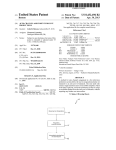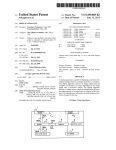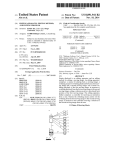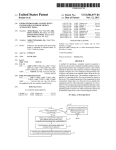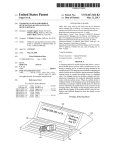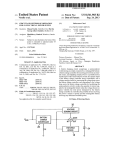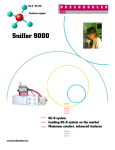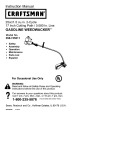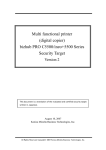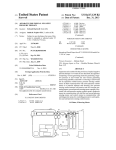Download Method and apparatus for automatically protecting a computer
Transcript
US008561192B2 (12) United States Patent (10) Patent N0.: (45) Date of Patent: Ye (54) METHOD AND APPARATUS FOR (56) U.S. PATENT DOCUMENTS 7,694,134 B2 Inventor: Oct. 15, 2013 References Cited AUTOMATICALLY PROTECTING A COMPUTER AGAINST A HARMFUL PROGRAM (75) US 8,561,192 B2 Chao Ye, Beijing (CN) (73) Assignees: Beijing Rising Information Technology Co., Ltd., Beijing (CN); Beijing Rising International Software Co., Ltd., Beijing (CN) 4/2010 Witt et al. 2002/0077803 A1* 6/2002 2004/0010718 A1 1/2004 Porras et a1. Kudoh et a1. ................... .. 704/1 2004/0049693 A1 3/2004 Douglas 2004/0193912 A1 2006/0075494 A1 9/2004 Li et al. 4/2006 Bertman et al. 2006/0136720 A1* 6/2006 2007/0107052 A1 5/2007 Cangini et al. Armstrong et a1. ......... .. 713/164 (Continued) Notice: Subject to any disclaimer, the term of this patent is extended or adjusted under 35 FOREIGN PATENT DOCUMENTS U.S.C. 154(b) by 687 days. (21) Appl. N0.: 12/738,023 (22) PCT Filed: Oct. 15, 2008 (86) PCT N0.: PCT/CN2008/072694 § 371 (0X1)’ (2), (4) Date: (87) CN CN 1409222 A 1550950 A 4/2003 12/2004 (Continued) OTHER PUBLICATIONS International Search Report corresponding to International Applica tion N0. PCT/CN2008/072694 dated Jan. 22, 2009. Aug. 13, 2010 (Continued) PCT Pub. No.: WO2009/049554 Primary Examiner * Michael S McNally PCT Pub. Date: Apr. 23, 2009 (74) Attorney, Agent, or Firm * Jenkins, Wilson, Taylor & Hunt, PA. (65) Prior Publication Data US 2010/0313269 A1 (57) Dec. 9,2010 ABSTRACT The present invention discloses a method and apparatus for (30) Foreign Application Priority Data automatically protecting computers against harmful pro grams. The method comprises: restricting an object program Oct. 15, 2007 (51) Int. Cl. (52) G06F 21/00 US. Cl. USPC (58) (CN) ........................ .. 2007 1 0180317 from accessing some resources in a computer system based on predetermined resource access rules; scanning computer resources accessed by the object program to determine Whether the accessed computer resources are infected by the (2013.01) .......................................................... .. object program; and analyzing malicious behaviors based on behavior characteristics of the object program to determine Whether the object program is a harmful program. 726/24 Field of Classi?cation Search USPC .......................................................... .. 726/24 See application ?le for complete search history. 12 Claims, 8 Drawing Sheets No 522 <-revenring > N Yes S2: "amassed ?blw Performmg momwring processing the mdlllona! Ye belng a vlrus me? 52A Prsvsmrng this ms access S26 Malicl nus program (heh 2Molsns sis. vllus DNA wgniuon 7 “5 s27 N_ ermlnalin isolating?an $25 VHS Terminalmg ms process and killing me malidous program ?le US 8,561,192 B2 Page 2 (56) References Cited US. PATENT DOCUMENTS OTHER PUBLICATIONS International Search Report corresponding to International Applica tion No. PCT/CN2008/072699 dated Jan. 22, 2009. 2007/0150956 A1 2007/0209076 A1 2010/0293615 A1 2010/0306851 A1 6/2007 Sharma et al. 9/2007 poner et al‘ 11/2010 Ye 12/2010 Zhou FOREIGN PATENT DOCUMENTS CN CN CN CN EP 1581088 1818823 1845120 1885224 1630711 A1 2/2005 8/2006 10/2006 12/2006 3/2006 _ _ _ _ International Search Report corresponding to International Applica tion No. PCT/CN2008/072698 dated Feb. 19, 2009. Of?ceAction correspondingto U.S.Appl. No. 12/738,031 dated Mar. 29, 20 12. Of?ce Action corresponding to US. Appl. No. 12/738,037 dated Apr. 12’ 2012 Of?ce Action corresponding to US. Appl. No. 12/738,037 dated Aug. 24, 2012. Of?ce Action corresponding to US. Appl. No. 12/738,031 dated Aug 24 2012 W0 WO 02/14987 2/2002 W0 W0 02/0615 10 8/2002 European Search Report corresponding to European Patent Applica ' ’ ' . . W0 WO W02009/049554 W02009/049555 4/2009 4/2009 thIl N0. EP I 630 711 dated Jan. 3, 2006. WO W02009/049556 4/2009 * cited by examiner US. Patent Oct. 15, 2013 V US 8,561,192 B2 Sheet 1 0f 8 RESOUI'C6 800685 rule COl'ltI‘Oi Resource access scan Malicious behavior analysis Create a new resource access rule A based on the determination result FIG.1 US. Patent 0a. 15, 2013 Sheet 2 0f8 US 8,561,192 B2 Intercepting file access 821 Yes Violating the file access rulesil No 822 823 Performing - N he accessed object , ________ “Yes the traditional being a virus file? monitoring processing Preventing this file access 826 Malicious program (behavior analysis, virus DNA recognition)? 827 Terminating and isolating? 828 Yes No ' Terminating the process and killing the malicious program file End 4 FIG.2 - S25 US. Patent 0a. 15, 2013 Sheet 3 0f8 US 8,561,192 B2 intercepting process starting / $31 iolating the proces tarting control rules? Yes 832 No—> $34 Yes v Preventing the object program from starting Malicious program (behavior analysis, virus DNA recognition)? 835 - nd isolating? S36 Terminating the process and killing v End the malicious program ?le ¢——j FIG.3 US. Patent 0a. 15, 2013 Sheet 4 0f8 US 8,561,192 B2 intercepting registry access iolating the Yes registry access rules? No 7 N O————~> Yes Preventing this registry ———-—-——-———> access Malicious program (behavior analysis, virus DNA Yes ecognition)? Terminating ' NO and isolating? No Yes V Terminating and isolating V End the process <-—-~—_— U.S. Patent 0a. 15, 2013 Sheet 5 0f8 US 8,561,192 B2 lntercepting system key API calling Yes iolating system action control? eventi Yes i Preventing this API ———-——--——> calling icious progr (behavior analysis, virus DNA ecognition)? erminating an isolating? No Yes V Terminating the process and killin the malicious program ?le End 4—»— US. Patent 0a. 15, 2013 Sheet 6 0f8 Obtaining the US 8,561,192 B2 S61 determmatlon _ result (inaccurate) S62 ‘A_ record of a _ malicious ?le emstmg 1n the result set? Yes 1 N0 Obtaining the record of the malicious ?le (?le name of the 563 malicious ?le) I Yes S64 corresponding program ?le being an executable ?le S65 Creating a start control rule i Applying to the resource access control layer End FIG.6 S66 US. Patent 0a. 15, 2013 Sheet 7 0f8 US 8,561,192 B2 S71 Obtaining the determination result (accurate) S72 A record of a malicious ?le existing in the resul set? Yes v Obtaining the S73 record of the malicious ?le (?le name of the malicious ?le) i S74 Creating an access control rule S75 Applying to the layer End US. Patent 0a. 15, 2013 Sheet 8 0f8 US 8,561,192 B2 .199 101 Resource access rule control 4 module 103 109 - Automatic Resource access scanning . module module 105 Y Malicious behavior analyzing module Virus DNA 1051 recognition module FIGS US 8,561,192 B2 1 2 In order to achieve this object, the method in accordance METHOD AND APPARATUS FOR AUTOMATICALLY PROTECTING A COMPUTER AGAINST A HARMFUL PROGRAM program from accessing some resources in a computer sys tem based on predetermined resource access rules; scanning FIELD OF THE INVENTION mine whether the accessed computer resources are infected with the present invention comprises: restricting an object computer resources accessed by the object program to deter by the object program; and analyzing malicious behaviors The present invention relates to a method and apparatus for based on behavior characteristics of the object program to determine whether the object program is a harmful program. automatically protecting a computer against a harmful pro The present invention also provides a computer automatic gram, and more particularly, to a method and apparatus for automatically protecting computers against harmful pro protection apparatus for implementing the above-described grams including such functions as resource access rule con method comprises: a resource access rule control module for trol, resource access scanning, malicious behavior analysis, restricting an object program from accessing some resources etc. in a computer system based on predetermined resource access rules; a resource access scanning module for scanning com BACKGROUND The rapid development of computer and network technolo gies greatly facilitates information interaction. However, with the development of these technologies, computer viruses are being evolved and updated continuously and become a seri 20 puter resources accessed by the object program to determine whether the accessed computer resources is infected by the object program; and a malicious behavior analyzing module con?gured to analyze malicious behaviors based on behavior characteristics of the object program to determine whether the object program is a harmful program. ous threat to normal uses of computers. Therefore, how to BRIEF DESCRIPTION OF THE DRAWINGS protect a computer against viruses has become a focus of people’s interest. An important step for protecting computers against viruses is to recognize viruses before running the ?le, which is usually called virus scanning, therefore appropriate 25 The present invention will be described in detail in con junction with the accompanying drawings and speci?c measures may be taken to protect computer systems from embodiments, where: being infected by viruses. A virus scanning method commonly adopted by prior anti a computer automatic protection method in accordance with virus software is signature matching method, which uses FIG. 1 illustrates a schematic diagram of an architecture of 30 the present invention; signatures (which are typically one or more segments of FIG. 2 illustrates a ?ow chart of a computer automatic speci?c binary code stream) extracted from virus samples to perform matching in the scanning ?les. Since the signatures protection method in accordance with an embodiment of the used in this method are extracted from the erupted or detected virus samples, they are ?xed signatures and usually lag 35 behind viruses. Thus, such method can not work in real-time monitoring and protection against those viruses in which the signatures are prone to change (i.e., the viruses prone to mutate) or new viruses (i.e., the viruses from which the sig natures have not been extracted). Particularly in recent years, with an increasing number of viruses and the emergence and 40 present invention when an object program attempts to access a ?le; FIG. 3 illustrates a ?ow chart of a computer automatic protection method in accordance with an embodiment of the present invention when an object program attempts to start a process; FIGS. 4 and 5 illustrate ?ow charts of a computer automatic protection method in accordance with the present invention when an object program attempts to access a registry and call development of anti-anti-virus technologies, the disadvan tage of lagging in the traditional “signature scanning” appears a system key API function, respectively; more and more serious, thereby resulting in many viruses being unable to be detected in real time. Once these real timely undetected viruses run, computer resources will be resource access rules based on the inaccurate determination FIG. 6 illustrates an automatic updating procedure of 45 result; FIG. 7 illustrates an automatic updating procedure of completely exposed to computer viruses and be arbitrarily resource access rules based on the accurate determination read or destroyed by them. Furthermore, as virus samples in the traditional “signature scanning” are usually required to be updated manually, they can not be added timely and automati result; and FIG. 8 illustrates a block diagram of a device for automati 50 cally. Such that the problem of lagging in traditional “signa accordance with an embodiment of the present invention. The like reference numbers refer to like or corresponding features or functions throughout. ture scanning” is more serious. In order to overcome the problem of lagging in the tradi tional “signature scanning” and prevent the running of com puter viruses from tampering or destroying sensitive cally protecting a computer against a harmful program in DETAILED DESCRIPTION 55 resources, there is a need for a new method and apparatus for The embodiments of the present invention will be described in detail with reference to the accompanying draw automatically protecting computers against harmful pro grams. ings. SUMMARY 60 An object of the present invention is to provide a computer automatic protection method capable of actively recognizing and killing unknown viruses in an accurate and timely man ner, while protecting security of the computer real-timely and actively by updating restriction rules without user’s partici pation. FIG. 1 illustrates a schematic diagram of an architecture of a computer automatic protection method in accordance with the present invention. As shown in FIG. 1, the computer automatic protection method in accordance with the present invention includes a three-layer structure in total from top to 65 bottom: the ?rst layer is resource access rule control process ing, the second layer is resource access scan processing, and the third layer is malicious behavior analysis processing. US 8,561,192 B2 3 4 Such three-layer structure combines the malicious behavior For example, when the object program only takes certain analysis and the resource access control with the traditional virus scanning method such that a malicious program can be detected in an accurate and ?eet manner, and the running actions to attack the system, the effect on a ?le may be not involved such that the resource access scan processing can be omitted. Malicious Behavior Analysis Processing thereof can be prevented timely. In the following, speci?c functions and components of the three-layer structure will be summarized respectively. Resource Access Rule Control Processing Resource access rule control processing is the ?rst layer structure, which is the most basic section of the computer protection method in accordance with the present invention, Malicious behavior analysis processing, as the third layer structure, determines whether the object program is harmful by monitoring the action of the object program on the basis of the two layers described above and based on the behavior performance (i.e., behavior characteristics) thereof. For example, when the object program implements self-replica tion and sets a global hook, the object program is determined to be harmful. Because the malicious behavior analysis because the running of a program often starts from resource access, for example, it is necessary for an object program to access an object ?le for starting the corresponding process of makes the determination based on the behavior characteris the object ?le. tics, it is able to recognize some unknown viruses. However, such analysis and determination have certain inaccuracies. Preferably, in order to avoid false alarm by the malicious In order to prevent malicious programs from making an attack or transmitting viruses by the utilization of system behavior analysis, a malicious behavior analysis technology resources, e.g., by accessing a ?le or registry or calling a speci?c system API function, some resource access rules are 20 predetermined in the ?rst layer structure. These predeter mined resource access rules are used for preventing portions of important resources in the system from being illegally accessed. These predetermined resource access rules, includ ing ?le access rule control, process start control, registry access rule control, system action rule control, etc, may be summarized and generated based on analyzing numerous 25 cases of infected users. ogy in the third layer structure. The virus “DNA” recognition technology is a technology which extracts characteristic sequences of unknown viruses by adopting a speci?c charac teristic discovery method, then compares them with known virus characteristics and ?nally ?nds the characteristic sequence with maximum similarity and greater than a speci?c threshold. A ?le corresponding to the found characteristic sequence is determined to be harmful. Speci?cally, in the third layer structure, after the analysis of malicious behaviors, Speci?cally, upon running, the resource access rule control processing ?rstly intercepts a request of an object program for accessing system resources, and then determines, based on the predetermined resource access rules, whether the object may be combined with a virus “DNA” recognition technol 30 a malicious program which is determined by analyzing the malicious behaviors may be con?rmed again as needed using the virus “DNA” recognition technology. The object program is determined to be harmful only when both the determination program is to access resources which are determined by the result of the malicious behavior analysis and the determina predetermined resource access rules as resources required to 35 tion result of the virus “DNA” recognition technology are be accessed and con?rmed. If the determination result isYes, then it is indicated that the current object program violates the harmful. Thus, unknown viruses can be discovered by the malicious behavior analysis while false alarm can be pre vented by means of the virus “DNA” recognition technology, resource access rules and may be a harmful program, such as Trojan, a virus, etc, and a query is required to check the legality of this resource access. The resource access rule control processing may restrict a thereby decreasing false alarm rate. 40 certain program before it accesses or executes a harmful program, or may restrict an executed harmful program when the executed harmful program accesses sensitive resources. Thus, such resource access rule control processing is able to 45 automatic updating procedure, a new resource access rule is created based on the determination result of the resource unknown viruses is achieved. Resource Access Scan Processing 50 ing resources accessed by an object program, such as a ?le, boot sector, mail, script, etc. For example, the resource access scan processing scans and recognizes viruses with regard to the intercepted context (e.g., ?le content, boot sector content, etc.) accessed by the object program to determine whether the content accessed by the object program is infected by viruses in the object program, thus determining whether the object ing the resource access rules will be described in detail below with reference to the ?gures. 55 In general, the computer automatic protection method in accordance with the present invention will be automatically running in the system to monitor the running of programs in a real time manner. However, a usecase can perform virus scanning in a non real-time manner by manually starting a scanning program. It is possible that the manual scanning 60 initiated by the user discovers virus ?les or ?les infected by viruses which have been disabled but not yet killed, and then kills these ?les timely. At this point, the virus ?les discovered by manual scanning may be accessed due to not being killed program is a harmful program. Since the second layer structure adopts an accurate virus scanning and recognition method, the determination result access scan processing and/or malicious behavior analysis processing and it is automatically updated to resource access control layer. The speci?c procedure of automatically updat is a traditional real-time monitor, which depends on virus scanning and recognizing technologies, mainly for monitor cally updating resource access rules based on the determina tion result from the second layer and/or the third layer. In the timely prevent the harmful program before it implements infringement, thereby the purpose of resisting attack of The second layer structure-resource access scan process ing is further performed on the basis of the resource access rule control processing. The resource access scan processing The three-layer structure of the computer automatic pro tection method in accordance with the present invention is described hereinabove in conjunction with FIG. 1. Further more, on the basis of the above three-layer structure, the present invention also comprises a procedure of automati timely, so the present invention also proposes a new resource 65 access rule being created based on the determination result of derived therefrom is reliable. In addition, in certain special manual scanning, and the new resource access rule is auto cases, the resource access scan processing may be omitted. matically updated to the resource access control layer. US 8,561,192 B2 6 5 The structure and some functions of the computer auto whether this process creating is prevented (step S34); other matic protection method in accordance with the present invention are described above generally. Various aspects of the present invention will be described separately in conjunc tion with speci?c embodiments. wise, it proceeds to step S33, in which the malicious behavior analysis is performed next. In step S32, the user is prompted whether to prevent this process from starting in order to prevent the started process from performing further infringement behaviors. If the user prevents this process from starting, the procedure proceeds to step S34, in which the process is prevented from starting. Then the procedure proceeds to step S33, in which the mali FIG. 2 illustrates a ?ow chart of a computer automatic protection method in accordance with an embodiment of the present invention when an object program attempts to access a ?le. cious behavior analysis is performed next, regardless of As shown in FIG. 2, after the object program that initiates ?le access (e. g., attempts access a system ?le) is intercepted, the resource access rule control processing of the ?rst layer whether the user preventing this process from starting. determines whether the ?le access violates a ?le access rule in In step S33, the malicious behavior analysis processing of the third layer analyzes malicious behaviors for this ?le the resource access rules in step S21, for example, write access to important data ?les (e. g., a host ?le) of the system is prohibited. If the ?le access violates the ?le access rule, then harmful program. In step S33, in order to avoid false alarm, the object program is also scanned and determined again as access to determine whether the object program may be a needed using the virus “DNA” recognition technology to determine whether the object program is harmful. The object the procedure proceeds to step S22; otherwise, it proceeds to step S23. In step S22, the user is prompted whether to prevent this ?le access to prevent the object program from further infringing program is determined to be harmful only when both deter 20 the procedure proceeds to step S23. If the user prevents this ?le access, the procedure proceeds to step S24, in which this ?le access is prevented. Then the procedure proceeds to step S26, in which the malicious behavior analysis is preformed and the object program is terminated and isolated as needed 25 (step S36), and then the procedure ends. FIGS. 4 and 5 illustrate ?ow charts of a computer automatic next. protection method in accordance with the present invention If it is determined that the ?le access rule is not violated in step S21 or it is determined that the current object program is not needed to be prevented from accessing in step S22, the object program is allowed to access, e.g., the system ?le. Then mination results are Yes. If the determination result of step S33 is No, the procedure ends. Otherwise, it is further determined whether the object program is required to be terminated and isolated (step S35), its accessed ?les. If the user does not prevent this ?le access, when an object program attempts to access a registry and call a system key API function, respectively. As illustrated, the 30 processing procedures of FIGS. 4 and 5 are similar to that of in step S23, the resource access scan processing of the second FIG. 3, the only difference is that they trigger different layer scans resources for the object accessed by the object resource access control rules, such as a registry access rule program to determine whether the accessed object is infected and system key API function call rule, and prevent different corresponding actions according to different operations that being attempted to start, for example, prevent registry access by viruses in the object program. When the determination result shows that the accessed object is infected, the proce dure proceeds to step S25, in which the traditional monitoring processing is performed, and then proceeds to step S26. When the determination result shows that the accessed object is not infected, the procedure also proceeds to step S26, in which the malicious behavior analysis is performed next. In step S26, the malicious behavior analysis processing 35 40 analyzes malicious behaviors for this ?le access to determine whether the object program may be a harmful program. In and prevent API calling. For the same portion of FIGS. 4 and 5 as FIG. 3, it may refer to the speci?c description of FIG. 3 and the detailed explanation thereof is omitted herein. In the procedure described above, many determination results may be obtained after the malicious behavior analysis determination, resource access scanning or manual scanning are performed. The determination results may be divided into two types based on the accuracy of the determination results: behavior analysis, it is scanned and determined again as (1) inaccurate determination result which includes the deter mination result from the malicious behavior analysis deter mination; (2) accurate determination result which includes needed using the virus “DNA” recognition technology to determine whether the object program is harmful. The object the determination result from the resource access scanning and manual scanning. Different resource access rules corre step S26, in order to avoid false alarm, when the object pro gram is determined to be a harmful program by the malicious 45 sponding to different determination results may be generated. program is determined to be harmful only when both deter mination results are Yes. 50 If the determination result of step S26 is No, the procedure ends. Otherwise, it is further determined whether the object program is required to be terminated and isolated (step S27), rate determination result; and a resource access rule that restricts the access to a virus ?le may be generated for the and the object program is terminated and isolated as needed (step S28), and then the procedure ends. accurate determination result. The resource access rule that 55 FIG. 3 illustrates a ?ow chart of a computer automatic protection method in accordance with an embodiment of the present invention when an object program attempts to start a process. As shown in FIG. 3, after the object program that initiates 60 a process starting action is intercepted, in step S31, the resource access rule control processing of the ?rst layer deter mines whether the process starting violates a process starting rule in resource access rules, for example, an unknown pro cess is prohibited from being started under a browser process. If the ?le access violates the process starting rule, the proce dure proceeds to step S32, in which it is further determined For example, a resource access rule that restricts the starting of a malicious program ?le may be generated for the inaccu restricts the starting of the program ?le may be generated as needed for the accurate determination result. An automatic updating procedure of the resource access rules of the computer automatic protection method in accor dance with the present invention will be described in details for the two types of different determination results described above. In Case of the Inaccurate Determination Result FIG. 6 illustrates an automatic updating procedure of resource access rules based on the inaccurate determination 65 result. As shown in FIG. 6, in step S61, after malicious behavior analysis determination is performed for the object program, US 8,561,192 B2 7 8 the determination result is obtained to get a determination result set, which is an inaccurate determination result. When the determination result is obtained, some of ?les which are determined to be malicious programs or ?les released by the the present invention, where the same components as those in the conventional computer system are omitted in this ?gure. malicious programs may have been killed during the afore mentioned resource scanning or malicious behavior analysis processing. A corresponding rule is not needed to be created for such non-existing ?les any more. Therefore, it is deter 101 con?gured to restrict an object program from accessing As illustrated in FIG. 8, the computer automatic protection device 100 includes a resource access rule control module some resources in a computer system based on predetermined resource access rules; a resource access scanning module 103 con?gured to scan computer resources accessed by the object program to determine whether the accessed computer resources are infected by the object program; a malicious mined whether a record of a malicious ?le exists in the result set in the following step (step S62). If it does not exist, the procedure ends directly and no more rules will be added. In general, the malicious program determined by one deter mination result may be not just a program ?le, but it may behavior analyzing module 105 con?gured to analyze mali cious behaviors based on behavior characteristics of the object program to determine whether the object program is a harmful program, and an automatic updating module 109 involve a number of ?les contained in a set of processes. These ?les may be such ?les that correspond to one or more con?gured to create a new resource access rule based on the processes created by the malicious program, or ?les released by the processes. In this embodiment, in order to reduce false determination results of the resource access scanning and the malicious behavior analysis, and add the new resource access alarm, a corresponding new resource access rule is created for only an executable ?le, i.e., an EXE ?le, which exists in the determination result set. Thus, when it is determined that the result set includes the record of the malicious ?le in step S62, information of the malicious ?le, such as ?le name, is obtained from the record of the malicious ?le (step S63), then it is determined whether the ?le is an EXE ?le (step S64). If rule to the existing resource access control layer to implement 20 automatic update. The malicious behavior analyzing module 105 may further include a virus “DNA” recognition module 1051 con?gured to determine the object program again using the virus “DN ” recognition technology after the object pro gram is determined by the malicious behavior analyzing the determination result isYes, the procedure proceeds to step 25 S65, in which a new rule is created. Otherwise, the procedure returns to step S62, in which it proceeds to obtain other malicious ?les in the result set. In step S65, the associated resource access rule, for example, the content of which is “any program being not 30 allowed to start the program ?le”, is created based on infor module 105 to be harmful. The object program is determined to be harmful only when both determination result of the malicious behavior analyzing module 105 and the determi nation result of the virus “DNA” recognition module 1051 are harmful. Bene?cial Effect To sum up, the method and apparatus for automatically mation of the extracted malicious EXE ?le, and the newly protecting computers against harmful programs in accor created rule is added to the existing resource access rules to dance with the present invention combines resource access control with resource access scanning and malicious behavior make it become effective (step S66). Finally, after the existing resource access rules are updated 35 automatically, the procedure returns to step S62 to proceed, analysis to automatically protect computers against harmful programs using a three-layer structure including the resource until corresponding resource access rules are created for all access control, resource access scanning and malicious the malicious ?les in the result set. In Case of the Accurate Determination Result FIG. 7 illustrates an automatic updating procedure of behavior analysis, such that restriction priority of the resource access rule control layer, timeliness and accuracy of the resource access scanning and fuzzy decision of the malicious behavior analysis can be fully utilized to solve the problem of 40 resource access rules based on the accurate determination result, i.e., the determination result of resource scanning and “lagging” existing in the traditional “signature scanning” manual scanning. technologies. The procedure shown in FIG. 7 is similar to that in FIG. 6, the difference is in that: as the determination result after the scanning is accurate, all the virus ?les determined in the determination result are required to be prohibited from being accessed when the rule is created. For this end, the step in FIG. 6, in which it is determined whether the malicious ?le is an EXE ?le, is omitted in the automatic updating procedure 45 dance with the present invention also has a resource access rule automatic updating function, and therefore may imple ment automatic adding of a resource access rule without user’s participation. As a result, the dif?culty in using the 50 shown in FIG. 7, while a corresponding resource access rule is created directly (step S74) for each virus ?le (step S72). In the example shown in FIG. 7, the resource access rule created for the virus ?le is “any program being not allowed to access the program ?le”. Therefore, it protects any program from 55 virus infection due to its access to the determined virus ?le. FIG. 6 may be referred for speci?c operations of steps S71, 60 The computer automatic protection method in accordance with the present invention is described in details hereinabove technology and false alarm rate is decreased. It should be understood by those skilled in the art that various modi?cations may be made to the method and appa ratus for automatically protecting computers against harmful in conjunction with the accompanying ?gures. The method may be implemented by computer software, computer hard FIG. 8 illustrates a block diagram of a computer automatic protection device 100 in accordance with an embodiment of in automatically protecting the computer against a harmful program is improved. In addition, owing to the combination of the malicious behavior analysis with the virus “DNA” recognition technol ogy, the virus “DNA” recognition technology is used for further con?rmation when possible malicious behaviors priately prevented by means of the virus “DNA” recognition steps in FIG. 6, and therefore the detail description thereof is ware or a combination thereof. resource access rule control layer is decreased and the ability occur, such that unknown viruses can be discovered by the malicious behavior analysis while false alarm can be appro S73 and S75 in FIG. 7 which are similar to the corresponding omitted. Meanwhile, the method and apparatus for automatically protecting computers against harmful programs in accor 65 programs disclosed in the present invention without departing from the content of the present invention. Therefore, the protection scope of the present invention should be de?ned by the content of the appended claims. US 8,561,192 B2 9 10 7. The method according to claim 1, wherein the predeter What is claimed is: 1. A method for automatically protecting a computer, com mined resource access rules include at least one of ?le access rules, process start control rules, registry access rules and system action rules. 8. The method according to claim 7, wherein the step of restricting an object program from accessing some resources prising: restricting an object program from accessing some resources in a computer system based on predetermined resource access rules; further comprises: scanning computer resources accessed by the object pro prompting the user to decide whether to prevent the access gram to determine whether the accessed computer resources are infected by the object program; analyZing malicious behaviors based on behavior charac teri stics of the object program to determine whether the object program is a harmful program; of the object program when it is determined that the object program have accessed the resources which are determined to be prohibited from being accessed in the resource access rules; and proceeding to the step of analyZing the malicious behaviors after the object program is prevented according to user’ s creating a new resource access rule based on results of the decision. scanning step, the analyZing step, or both, wherein when the analyZing step determines that the object program is 9. The method according to claim 8, further comprising: proceeding to the step of scanning the computer resources a harmful program, the created new resource access rule if the user decides not to prevent the object program. includes instructions for disallowing a program ?le associated with the harmful object program from being started by any program; and 10. An apparatus comprising: 20 automatically adding the new resource access rule created to the predetermined resource access rules. 2. The method according to claim 1, wherein the step of creating the new resource access rule comprises: when the step of scanning the computer resources deter 25 the created new resource access rule includes instruc tions for disallowing the infected computer resources create a new resource access rule based on results of scan from being accessed by any program. 30 created new resource access rule includes instructions for disallowing a program ?le associated with the harm ful object program from being started by any program; 35 11. The apparatus according to claim 10, wherein: when the scanning of the computer resources determines 40 for disallowing the infected computer resources from instructions for disallowing the virus ?les found out by the manual scanning or the ?les infected by viruses from being accessed by any program. 12. The apparatus according to claim 10, wherein the pro being accessed by any program. cessor is further con?gured to: 6. The method according to claim 1, wherein the step of analyze the object program using a virus “DNA” recogni tion technology after the object program is determined analyZing the malicious behaviors further comprises: if the step of analyZing the malicious behaviors determines determining that the object program is a harmful program when the object program is determined to be a harmful program by both the malicious behavior analysis and the virus “DNA” recognition technology. that the accessed computer resources are infected, the created new resource access rule includes instructions new resource access rule comprises: technology; and and automatically add the created new resource access rule to the predetermined resource access rules. the step of creating the new resource access rule further comprises creating the new resource access rule based that the object program is a harmful program, analyZing the object program using a virus “DNA” recognition ning the computer resources, analyZing the malicious behaviors, or both, wherein when the analyZing deter mines that the object program is a harmful program, the infected by viruses; and on the result of the manual scanning. 5. The method according to claim 4, wherein the created infected by the object program; and analyze malicious behaviors based on behavior character istics of the object program to determine whether the object program is a harmful program; mines that the accessed computer resources are infected, 3. The method according to claim 1, wherein the program ?le associated with the harmful object program is an execut able program ?le. 4. The method according to claim 1, further comprising: performing, by a user, manual scanning to scan and kill virus ?les existing in the computer system and ?les a processor, wherein the processor is con?gured to: restrict an object program from accessing some resources in a computer system based on predetermined resource access rules; scan computer resources accessed by the object program to determine whether the accessed computer resources are to be a harmful program by analyZing of the malicious behaviors, wherein 50 the object program is determined to be a harmful program only when the object program is determined to be a harmful program by both the analyZing of the malicious behaviors and the virus “DNA” recognition technology. * * * * * UNITED STATES PATENT AND TRADEMARK OFFICE CERTIFICATE OF CORRECTION PATENT NO. I 8,561,192 B2 APPLICATION NO. : 12/738023 : October 15, 2013 : Chao Ye DATED INVENTOR(S) Page 1 ofl It is certified that error appears in the above-identi?ed patent and that said Letters Patent is hereby corrected as shown below: On title page, item 73 Assignees replace “Beijing Rising Information Technology Co., Ltd. (Beijing, CN); Beijing Rising International Software Co., Ltd. (Beijing, CN)” With --Beijing Rising Information Technology Co., Ltd. (Beijing, CN)--. Signed and Sealed this Eighteenth Day of March, 2014 WMZ44L_ Michelle K. Lee Deputy Director 0fthe United States Patent and Trademark O?ice




















